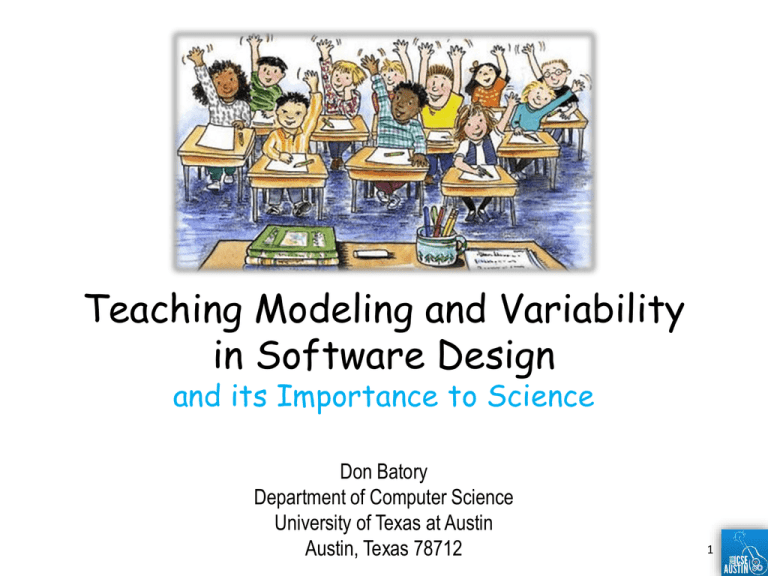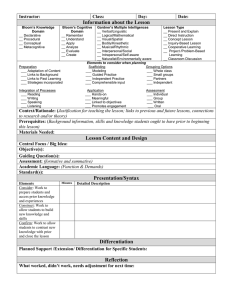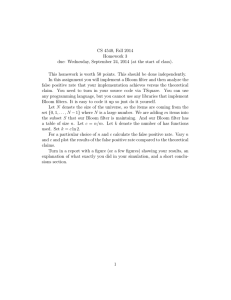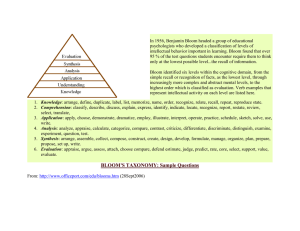Teaching Modeling and Variability in Software Design and its Importance to Science
advertisement

Teaching Modeling and Variability in Software Design and its Importance to Science Don Batory Department of Computer Science University of Texas at Austin Austin, Texas 78712 1 Overture • My work is in automated software design (ASD) • my interests: software product lines (SPLs), model driven engineering (MDE), refactoring • background in systems, not formal methods • flavor of my work is to use mathematics to explain what I have observed and done in practice from practice to theory 2 Heard Lectures by Jay Misra Tony Hoare Ric Hehner • Their work is to find algebraic laws of programming (esp. concurrency) • My approach to software automation has this flavor (physics), but is not as formal • geared more toward practicing engineers • does not preclude others with stronger formal backgrounds to follow up 3 Recent Lectures by Jay Misra Tony Hoare Ric Hehner • Their work is to find algebraic laws of programming • My approach to software automation has this flavor (physics), but is not as formal • geared more to practice and engineering • does not preclude others with stronger formal backgrounds to follow up 4 Introduction • I teach undergraduate and graduate software design courses • Goal is not JUST to present software design as: • a collection of best practice techniques and tools to create understandable and cost-effective designs, but also • a foundation to explain classical and revolutionary concepts in last 25 years Model Driven Engineering Refactorings Design Patterns Parallel Architectures Product Lines 5 Motivation #1 For This Talk • I attended Software Product Line Conference in Nashville last summer • Listened to a keynote of a founder of that Conference Series • History and motivation behind the creation of SPLC • Software Reuse Conference lacked a focus on practical, cost-effective technology • and “we didn’t have to worry about math” 6 Not Surprising • Historically w.r.t. science, I think Software Design is ~1880s • Practice as an art dominated in chemistry • Against the tide of the history of science In practice, there is no difference between theory and practice. In theory, there is. 7 The Difference is Obvious • View Software Design from reductionist and mathematical perspective • Only if you’re in the right place • At the right time • Looking in the right direction • You’ll discover something beautiful 8 A Starting Point to Teach Modern Software Design 9 Basic Mathematics • Addition and subtraction of numbers identity commutativity associativity 𝐴+0=𝐴 𝐴+𝐵 =𝐵+𝐴 𝐴 + (𝐵 + 𝐶) = (𝐴 + 𝐵) + 𝐶 • Some operations (multiplication) distribute over addition 𝑅⋅ 𝐺+𝐻 =𝑅⋅𝐺+𝑅⋅𝐻 • Functions 𝐹: ℝ → ℝ not in this talk… 10 Dreaded Homework Assignments • Are these expressions equal? 𝑥2 + 5 ⋅ 𝑥 + 6 = 𝑥 + 3 ⋅ (𝑥 + 2) • Obviously no! They are different • We were taught to apply a series of identities replace equals with equals to prove their semantic equality or not 𝑥+3 ⋅ 𝑥+2 = 𝑥+3 ⋅𝑥+ 𝑥+3 ⋅2 = 𝑥2 + 3 ⋅ 𝑥 + 2 ⋅ 𝑥 + 6 = 𝑥2 + 5 ⋅ 𝑥 + 6 11 MDE Cosmic View • We have a domain of algebraic expressions defined by metamodel 𝔼 metamodel of all algebraic expressions 𝔼 cone of instances 𝑒1 𝑒2 domain of all algebraic expressions 𝔼 instances • We have 2 elements: expressions 𝑒1 and 𝑒2 • Is there a path proof between 𝑒1 and 𝑒2 using arrows identities that transforms 𝑒1 into 𝑒2 ? 12 MDE Cosmic View • Of course, there can be many paths derivations • Can derive a large number of semantically equivalent expressions metamodel of all expressions 𝔼 cone of instances 𝑒1 𝑒2 domain of all 𝔼 instances • Yields a subdomain of “equivalent expressions” • A common source of variability in mathematics that we don’t think about • You might say some expressions are better than others. More later… 13 Incremental Software Design • Is a classical way to control software complexity 𝑃0 𝜏1 𝑃1 𝜏2 𝑃2 𝜏3 𝑃3 • Hallmark of Agile approaches, like XP • Goal of Automated Software Design is to automate all or some the common arrows/transformations of software design • “all” is more likely in domain-specific applications • “some” expected in generic applications, like refactorings 14 Automated Software Design • Programs are graphs Class Diagrams Data Flow Parse Trees 15 Automated Software Design • Deals with the addition and subtraction of graphs, not numbers, w. similar properties identity commutativity associativity 𝐴+0=𝐴 𝐴+𝐵 =𝐵+𝐴 𝐴 + (𝐵 + 𝐶) = (𝐴 + 𝐵) + 𝐶 • Some operations distribute over addition: make graph 𝑅ed 𝑅⋅ 𝐺+𝐻 =𝑅⋅𝐺+𝑅⋅𝐻 • Functions 𝐹: 𝔾 → 𝔾 not in this talk! 16 Make This Concrete! 𝛿+𝛾 =ϕ • Start with UML class diagrams A 𝛿= -x -y - + is a union-like op that has an identity 0, is commutative and associative – is a set subtraction operation -in 1 -contains * B -r - 𝛾= 𝜙= 17 CUTE BUT SO WHAT? 18 How Would You Explain • A typical spaghetti class diagram to someone? 1 Customer * 1 Receipt -paid * 0..1 * 1 * CarRentalCompany 1 1 -belongsTo * -owns RentalCar Contract * * 1 19 Using Graph Addition • Build graph incrementally by adding subgraphs to a simple base graph -paid Customer Receipt 1 1 * * 0..1 * * Car Rental Company Contract 1 1 -belongsTo * -owns Rental Car 1 * Explain Complexity in a Simple Way 1 1 • Each step is understandable, implementable, and testable! 20 No Unique Way to Construct Diagram • Consequence of commutativity and associativity of graph addition -paid Customer Receipt 1 1 * * 0..1 * * Car Rental Company Contract 1 1 -belongsTo * -owns Rental Car 1 * 1 1 • Math confirms the intuitive: one can create a design in any number of equivalent ways – more later… 21 CUTE BUT WHO CARES? 22 Graph Identities often presented as Refactorings • Push down association A 1 B * * * A B 0..1 C C D 0.. 1 D Each A is connected to exactly 1 C or 1 D, Never both • Refactorings are reversible (equalities) • Lots of these identities – see more later… 23 MDE Universe • Metamodel ℂ𝔻 whose domain is class diagrams metamodel of all class diagrams ℂ𝔻 cone of instances 𝑐1 𝑐2 domain of all class diagrams • Given two class diagrams, 𝑐1 and 𝑐2 , does 𝑐1 = 𝑐2 ? • Can we apply a set of graph identities to prove their equivalence? • Let’s a look at an example 24 Motivation #2 for this Talk • “Abstraction Challenges” Panel at MODELS 2013 • I posed a question: if I give a modeling assignment** to my class… ** create a class diagram to express … • Response caught me off-guard • if panelists said anything it was “but there is only one right answer” 25 Guess: Common Interpretation thank you Davide! • Example from Davide Di Ruscio clarified a common interpretation – What is a class diagram of a class diagram? a) allows classes to have attributes and directed associations b) answer (a) + class hierarchies c) answer (b) + pull-up common attributes name 26 Teaching Databases Mid-1980s • I noticed the same problems • unless you are very specific about what you want students to model, you will get a zoo answers • I graded the same way as Davide… • Decades later, in teaching Software Design, I took a broader perspective, I realized I needed to tighten the problem spec to reduce the zoo of answers 27 Where I Start Now • What is a class diagram of a class diagram? • Here is my in-class answer: -endsAt Box Line -name 1 1 -attrOf 1 -endOf * -hasAttr 2 -hasEnd Attribute -name -visibility? -connectsTo * LineEnd -name -visible? -cardinality • For MDE purists, this CD is an instance of itself 28 The Assignment • Given this metamodel, what minimal change do you need to make to generalize it to express inheritance relationships among classes? • And I get all sorts of answers… -endsAt Box Line -name 1 1 -attrOf 1 -endOf * -hasAttr 2 -hasEnd Attribute -name -visibility? -connectsTo * LineEnd -name -visible? -cardinality 29 Answers #1 and #2 • The left answer is my answer + constraint that there are no inheritance cycles not shown * inheritancePair -sub -endsAt Box -super -sub * Line -super -name 0..1 1 1 -endsAt Box Line -name 1 1 0..1 1 -attrOf 1 -endOf 1 -attrOf 1 -endOf * -hasAttr 2 -hasEnd * -hasAttr 2 -hasEnd Attribute -name -visibility? -connectsTo * LineEnd -name -visible? -cardinality let’s hope we agree on cardinality labeling, as it is non-standard. I use Booch et al. UML convention Attribute -name -visibility? -connectsTo * LineEnd -name -visible? -cardinality 30 Graph Identities Known Beforehand a.k.a. Refactorings • A standard rewrite of database design circa mid-1980s called “normalize” association A A -End1 * -End2 B B 1 * -End2 ABPair * * 1 -End1 • And, of course, the rename refactoring which asserts “X” equals “Y” X Y 31 Graph Identities Known Beforehand a.k.a. Refactorings • A standard rewrite of database design circa mid-1980s called “normalize” association A AA -End1 BB -End2 * B 1 * -End2 ABPair ABPair * * 1 -End1 • Special case where A = B * AAPair -E n d 1 -E n d 2 * 1 -End1 1 A -End2 A * * 32 So Let’s Derive their Equivalence * -sub * Box -super BoxBoxPair -sub normalize -name -super 0..1 1 1 Box -name 0..1 * inheritancePair equals -sub -super 0..1 1 1 Box -name • Of course, the right diagram is more verbose than the left, but they are equivalent • They don’t get equivalent grades because the right CD is not minimal 33 Here’s Another Student Answer * inheritancePair -sub 1 Inheritance 1 -endsAt Box Line -name -super 0..1 1 -endsAt Box 1 Line -name 1 1 1 -attrOf 1 -endOf 2 1 -attrOf 1 -endOf * -hasAttr 2 -hasEnd * * -hasAttr Attribute -name -visibility? 2 -connectsTo * -hasEnd InheritEnd -diamondEnd? LineEnd Attribute -name -visibility? -name -visible? -cardinality -connectsTo * LineEnd -name -visible? -cardinality • Constraint on both diagrams: no box can have multiple super classes, no inheritance cycles, … 34 Again Use Normalization InheritancePair 0..1 Super 1 1 InheritancePair 1 -super 1 -sub normalize -sub -super * 0..1 Box 1 * 1 Box InheritancePair Super 1 normalize 1 1 -super 0..1 1 1 Sub * 1 Box -sub 35 Next… InheritancePair InheritancePair Super Super 1 1 1 -super 1 0..1 equals 1 1 Sub * 1 Box 2 SuperSub * 1 Box -super? -sub Each InheritancePair has precisely 1 “super” End and 1 “sub” end 36 Last Step InheritancePair InheritancePair 1 1 equals 2 SuperSub 2 * 1 * InheritEnd Box 1 Box -super? -super? Each InheritancePair has precisely 1 “super” End and 1 “sub” end Each InheritancePair has precisely 1 “super” End and 1 “sub” end 1 Inheritance Box * inheritancePair 1 -sub -super 0..1 1 1 Box -name 2 InheritEnd * -super? Each Inheritance precisely 1 “super” InheritEnd37 Each Inheritance has has precisely 1 “super” InheritEnd And2+1 “super” “sub” InheritEnd No class has SuperEnds Big Picture metamodel of all class diagrams • Graph refactorings are Graph identities • We should be teaching is the mathematics of software design – this is the Science of Design • Variations in designs are explained by the application of graph identities • Interesting assignments for students to think about what identities they need to grade each other’s answers ℂ𝔻 Cone of Instances 𝑚 𝑠 domain of all ℂ𝔻 instances 38 CUTE BUT ENGINEERS DON’T NEED THIS… 39 Really??? 40 Really??? 41 Science is Everything in ASD • It is the cooperation of theory and experiments • experiments give observational data • theory distills seemingly unrelated observations into a system of laws • Go back in time to see the origins of Automated Software Design (ASD) 42 In ~1986, Keys to the Future of Software Development • Paradigms of the future must embrace at least: • Compositional Programming – develop software by composing “modules” (not writing code) • Generative Programming – want software development to be automated • Domain-Specific Languages (DSLs) – not C or C++, use domain-specific notations • Automatic Programming – declarative specs → efficient programs • Verification – want our programs to be correct • Need simultaneous advance in all fronts to make a significant impact 43 Yeh, Right • But … an example of this futuristic paradigm realized 7 years earlier (1979) around time when many AI researchers gave up on automatic programming Selinger ACM SIGMOD 79 • IMO – most significant result in ASD and automated construction. Period. • Rarely mentioned in typical texts and research papers in SE, software design, modularity, product lines, DSLs, MDE, software architectures… 44 Relational Query Optimization (RQO) compositional programming SQL select statement parser inefficient relational algebra expression declarative domain-specific language optimizer automatic programming efficient relational algebra expression generative programming code generator efficient program correct-by-construction (see this later) 45 What RQO Did • • • • Started with a simple relational algebra expression 𝑒1 derived from SQL SELECT Applying algebraic identities, created a subdomain of equivalent expressions, incl 𝑒2 Ranked expressions by efficiency and chose the cheapest, ex: 𝑒2 That’s the implementation of the SQL SELECT to use metamodel of all relational algebra expressions ℝ𝔼 cone of instances 𝑒1 𝑒2 domain of all relational algebra expressions 46 Keys to RQO Success • Automated development of query evaluation programs • hard-to-write, hard-to-optimize, hard-to-maintain • revolutionized and simplified database usage • Based on algebra of tables (not numbers) • different table expressions represented different programs • Program designs / expressions can be optimized automatically • key is finding relational algebra identities • Gave me a framework about how to think about ASD 47 NICE SHOW ME SOMETHING USEFUL 48 Really?? • Revolutionizing database management was not useful? • While you think about an answer, let me show others this example about dataflow applications… 49 How Do You Explain… • This spaghetti diagram: it is a dataflow graph of a fundamental parallel hash join algorithm, similar to what is used in database machines today DeWitt, et al. IEEE TKDE 1990 HJOIN A1 A BLOOM ... HSPLIT An BLOOM HJOIN A ⋈B 1 1 MERGE ... BFILTER B HSPLIT B1 ... Bn BFILTER A⋈B An⋈Bn HJOIN • To explain & derive it, you need data flow graph identities 50 Simple Way To Derive Gamma • Need 2 identities that are well-known to database researchers but few others • Bloom filters remove tuples from stream B that provably cannot join with stream A HJOIN A B bloom filter HJOIN A A⋈B BLOOM HJOIN A⋈B BFILTER B • Parallelize HJOIN operation via map-reduce: HJOIN A B map reduce HJOIN A HSPLIT A1 An A⋈B HJOIN A1⋈B1 ... B HSPLIT B1 Bn HJOIN A⋈B MERGE An⋈Bn 51 Derivation of Gamma A B HJOIN A⋈B HJOIN map reduce A HSPLIT A1 An HJOIN A1⋈B1 ... B HSPLIT B1 Bn HJOIN MERGE A⋈B An⋈Bn HJOIN A1 A HSPLIT BLOOM HJOIN An bloom filter A1⋈B1 BFILTER ... MERGE A⋈B HJOIN B HSPLIT B1 Bn An⋈Bn BLOOM HJOIN BFILTER 52 Derivation of Gamma HJOIN A1 A HSPLIT BLOOM HJOIN An A1⋈B1 BFILTER ... MERGE A⋈B HJOIN B HSPLIT B1 Bn An⋈Bn BLOOM HJOIN BFILTER HJOIN A1 graph rearrangement A BLOOM ... HSPLIT An BLOOM HJOIN A ⋈B 1 1 MERGE ... BFILTER B HSPLIT B1 ... Bn BFILTER A⋈B An⋈Bn HJOIN 53 Design is Correct By Construction A B • Initial graph is correct • Rewrites are correct A B HJOIN HJOIN bloom filter HJOIN A⋈B BLOOM A A⋈B HJOIN A⋈B BFILTER B HJOIN A B map reduce HJOIN HSPLIT A A1 An A⋈B HJOIN A1⋈B1 ... B HSPLIT B1 Bn HJOIN MERGE A⋈B MERGE A⋈B An⋈Bn HJOIN • End result is correct A1 A BLOOM ... HSPLIT An BLOOM HJOIN A1⋈B1 ... BFILTER B HSPLIT B1 ... Bn BFILTER An⋈Bn HJOIN 54 Remember! • There are many ways to derive the same graph • simple exploration of this space reveals other fundamental identities HJOIN A B bloom filter HJOIN BLOOM A HJOIN A⋈B A⋈B BFILTER B HJOIN BLOOM A1 A BLOOM HJOIN A1 MERGE HSPLIT HJOIN ... HSPLIT An A*B MERGE ... An BLOOM A1 B’1 MMERGE HSPLIT M M1 map reduce BFILTER M1 MSPLIT BFILTER HJOIN An B’n B’ B’1 Mn MERGE ... B HSPLIT B’n B1 Bn BFILTER 55 Identity Optimizations • Merge tuple streams 𝐴1 … 𝐴𝑛 into A and then reconstitute them A1 MERGE A A1 HSPLIT An A1 A1 An An optimize An • Merge bitmaps 𝑀1 … 𝑀𝑛 into a single bitmap 𝑀 and recreate bitmaps 𝑀1 … 𝑀𝑛 M1 MMERGE Mn M M1 MSPLIT Mn M1 M1 Mn Mn optimize 56 Derivation HJOIN BLOOM A1 A BLOOM HJOIN A1 MERGE HSPLIT MMERGE HSPLIT HJOIN ... HSPLIT An A1 B’1 A*B MERGE ... An BLOOM M M1 BFILTER M1 MSPLIT HJOIN An B’n This is another way to discover graph identities. B’ BFILTER B’1 Mn MERGE ... B HSPLIT B’n B1 Bn BFILTER HJOIN A1 A BLOOM ... HSPLIT An BLOOM HJOIN A ⋈B 1 1 optimize BFILTER B HSPLIT B1 ... Bn BFILTER A⋈B MERGE ... An⋈Bn HJOIN 57 DON TOO FANCY FOR ME; I PREFER MY WAY 58 I Understand… • That’s exactly what Chemists said in the 1880s… • but this will change and will take time… • if it were easy, would have been done years ago Let me show you a difference between manual software development and automated design in another fundamental area of CS 59 Dense Linear Algebra (DLA) • Robert van de Geijn • last 30 years creating elegant mathematically layered designs of DLA computations • Jack Paulson created Elemental Distributed DLA package • standard BLAS3 matrix-matrix operations • solvers • decomposition functions (Cholesky factorization) • eigenvalue problems • Bryan Marker mechanized the above work as application of dataflow identities • DxTer name of his tool 60 What DxTer Does • • • • Starts with a simple DLA dataflow graph 𝑔1 specified by library designer or DLA user Applies algebraic identities & creates a subdomain of equivalent graphs, incl 𝑔2 Ranks graphs by their estimated efficiency and choses the cheapest, ex: 𝑔2 That’s the implementation that is translated to code metamodel of data flow graphs 𝔻𝔽 cone of instances 𝑔1 𝑔2 domain of all data flow graphs 61 Performance Results Machine # of Cores Argonne’s BlueGene/P (Intrepid) Texas Advanced Computing Center (Lonestar) 8,192 240 Peak Performance 27+ TFLOPS 3.2 TFLOPS • DxTer automatically generated & optimized Elemental code for BLAS3 and Cholesky operations • Benchmarked with manually-written ScaLAPACK • vendors standard option for distributed memory machines; auto-tuned or manually-tuned • only alternative available for target machines 62 14000 Gemm NN Gemm NT Gemm TN Gemm TT Symm LL Symm RL Symm LU Symm RU Syr2k LN Syr2k LT Syr2k UN Syr2k UT Syrk LN Syrk LT Syrk UN Syrk UT Trmm LLNN Trmm RLNN Trmm LLTN Trmm LUNN Trsm LLNN Trsm RLNN Trsm LLTN Trsm LUNN Performance (GFLOPS) BLAS3 Performance on Intrepid 18000 16000 ScaLAPACK DxTer 12000 10000 8000 6000 4000 2000 0 63 14000 Gemm NN Gemm NT Gemm TN Gemm TT Symm LL Symm RL Symm LU Symm RU Syr2k LN Syr2k LT Syr2k UN Syr2k UT Syrk LN Syrk LT Syrk UN Syrk UT Trmm LLNN Trmm RLNN Trmm LLTN Trmm LUNN Trsm LLNN Trsm RLNN Trsm LLTN Trsm LUNN Performance (GFLOPS) BLAS3 Performance on Intrepid 18000 16000 ScaLAPACK DxTer 12000 10000 8000 6000 4000 2000 0 64 Bryan Found • Error(s) in Elemental Library • Instances where the Domain Expert Jack forgot to apply an optimization • Or used the wrong algorithm (performance error) 65 What is Really Important… • New hardware architectures are invented every year • DLA algorithms that are optimized for 1 architecture are not optimized for another… • Porting DLA libraries either • runs slower than optimal – which is costly • rewrite much from scratch – which is costly 66 Next Stop – Tensors! • Tensor • n – dimensional array • Tensor Contraction • generalization of matrix multiplication • Tensors = matrices on steroids • Based on ROTE Library of Martin Schatz 67 Next Stop • Generalized computations to tensor equations in Computational Chemistry • Here are the CCSD coupled cluster single double equations for accurate reproduction of experimental results on electron correlation for molecules • Bryan & Martin created a dataflow graph of these equations and DxTer to optimize their implementation 68 Next Step • Generalized computations to tensor equations in Computational Chemistry • Here are the CCSD coupled cluster single double equations for accurate reproduction of experimental results on electron correlation for molecules • Marker created a dataflow graph of these equations and DxTer to optimize their implementation 69 State of the Art • Contestant: CTF – Cyclops Tensor Framework • state-of-the art distributed library for tensor computations • performs one contraction (tensor multiply) at a time • chooses among different algorithms • Machine: Benchmark on BlueGene/Q • 16 shared-memory cores of IBM’s 64-bit Power A2 architecture @ 1600MHz • each node has 16 GB of memory • ran CCSD on 256 of these nodes, for a total of 4096 cores 70 Performance of Full CCSD on 4096 cores, ¼ peak on top approx 1.3x larger problems approx 1.4x faster This is good! 71 Performance of Full CCSD on 4096 cores, ¼ peak on top approx 1.3x larger problems approx 1.4x faster This I is good! 72 73 DON, I DON’T WANT TO WORRY ABOUT MATH 74 30 Years Ago • This leap forward could not have been done or would not believable • simply didn’t have the “observational” data to propel us forward • each “experiment” to derive programs from graph identities took ~4 years • had to look at several domains to see the commonalities → more years • took years to bring the pieces together → doesn’t happen over night • And this is Hard: If there is anything I’ve learned from programming and my career: 75 And If You Do It Right… • You will know you are successful when people ask… • Here, in summary, are my take-away ideas… 76 Finding Domain-Specific Identities • Is a fundamental activity in Science, like Physics ℏ 𝜎𝑥 𝜎𝑦 ≥ 2 ℏ2 2 𝚤ℏΨ 𝒓, 𝑡 = − 𝛻 Ψ 𝒓, 𝑡 + 𝑉(𝒓, 𝑡)Ψ(𝒓, 𝑡) 2𝑚 77 Finding Domain-Specific Identities • Is a fundamental activity in Science, like Physics ℏ 𝜎𝑥 𝜎𝑦 ≥ 2 ℏ2 2 𝚤ℏΨ 𝒓, 𝑡 = − 𝛻 Ψ 𝒓, 𝑡 + 𝑉(𝒓, 𝑡)Ψ(𝒓, 𝑡) 2𝑚 78 Finding Domain-Specific Identities • Is also a fundamental activity in Automated Software Design B A -End1 D -End2 * 0..1 * A 1 0.. C A ch Ea on is c on tly ac ex o dt cte ne eC B 0..* D or A * B 1 -End2 ABPair 0..* 1 * B -End1 1 D * A C HJOIN HSPLIT A X A B Y A1 An A*B HJOIN HJOIN A1*B1 ... B HSPLIT B1 Bn HJOIN MERGE An*Bn A1 HJOIN MERGE An A*B HJOIN M BLOO A A*B A B HJOIN A HSPLIT A1 identity An ER BFILT A1 A1 An An 0..* B AAPair -End1 -End2 0..* 1 A -End2 * 1 -End1 * A 79 A*B Finding Domain-Specific Identities • Is also a fundamental activity in Automated Software Design B A -End1 D -End2 * 0..1 * A 1 0.. C A ch Ea on is c on tly ac ex o dt cte ne eC B 0..* D or A * B 1 -End2 ABPair 0..* 1 * B -End1 1 D * A C HJOIN HSPLIT A X A B Y A1 An A*B HJOIN HJOIN A1*B1 ... B HSPLIT B1 Bn HJOIN MERGE An*Bn A1 HJOIN MERGE An A*B HJOIN M BLOO A A*B A B HJOIN A HSPLIT A1 identity An ER BFILT A1 A1 An An 0..* B AAPair -End1 -End2 0..* 1 A -End2 * 1 -End1 * A 80 A*B Teaching Math in Software Design is Important • Foundation of Science • Shows algebraic foundations of advances in last 25 years in Software Design: Model Driven Engineering Refactorings Design Patterns Parallel Architectures Product Lines 81 Remember History of Science • Greatest technical advances in last century were via science • It will be no difference for software design • It is now time to prepare our students for the future, not to continue the past Even if you are a dog… Thank You! 82



